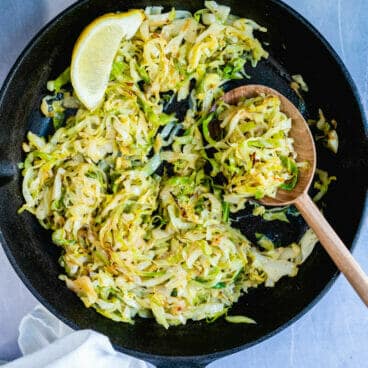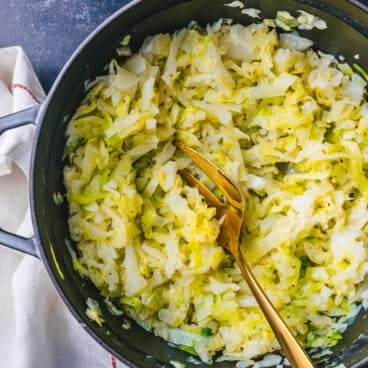Oh, hi! Welcome to Fermentation 101. We’re your hosts, Sonja and Alex. And we can’t wait for you to experience the magic of fermentation through sauerkraut! After taking you through our simplified guide to sourdough bread, we wondered: what other DIY projects can we break down? Where we landed was homemade sauerkraut. It’s easy to make, simple to ferment, and a seriously healthy probiotic-filled addition to any meal. The best part: Alex and I have researched everything so that you don’t have to. Ready to get started?
What is sauerkraut?
OK, so what is sauerkraut? In a nutshell: thinly sliced, fermented raw cabbage. Sauerkraut is made by a process called lacto-fermentation. Lacto-fermentation is a process that also makes kimchi: and all you need is salt, vegetables, and water. And it turns into one of the best cabbage recipes there is. How does it all work? Without getting too technical: lactic bacteria is present in the vegetables. And during fermentation, it goes to work turning sugars into lactic acid. Lactic acid is a natural preservative that inhibits the growth of harmful bacteria. Along with preserving, the fermentation process also increases vitamin levels and improves digestibility of whatever is being fermented. More fermented foods? Go to Top Fermented Foods to Try Now.
Is sauerkraut good for you?
In a word: Yes! Fermented foods like sauerkraut, kimchi and kombucha have become the health craze of the moment. What’s all the fuss about? Fermented foods can give your body a dose of healthy probiotics, which are live microorganisms crucial to healthy digestion, says Dr. David S. Ludwig, a professor of nutrition at the Harvard School of Public Health. So eating sauerkraut can contribute to better gut health! An interesting note: canned sauerkraut does not contain probiotics, because they’re killed in the canning process. So making this homemade sauerkraut recipe guarantees you’ll get those live cultures right into your jar! (If you’re worried about this when buying store bought, make sure to get refrigerated sauerkraut, not canned.)
Tools for making homemade sauerkraut
OK, let’s get to how to make sauerkraut! Alex has combed through all the research to find exactly what you’ll need for your home fermentation experiments. Here’s what you’ll need: That’s it! For a kitchen DIY project, it’s a pretty low ask. Ready for the good part? Keep reading.
Tips for how to make sauerkraut
Before you get to the recipe below: let’s talk about a few tips! Here are a few things we learned along the way about how to make sauerkraut:
Cut the cabbage into shreds using our easy method. Have you had these problems with cabbage? Uneven pieces, the knife slipping, cabbage all over the counter? We did, until we learned this: how to cut cabbage…the right way!. Use a room temperature cabbage. This might sound silly, but you’ll need to squeeze the shredded cabbage with your hands for about 10 minutes. And there’s nothing worse than putting your hands into freezing cold cabbage! The easiest way to do this is to have it at room temperature. Squeeze a LOT. The squeezing part takes quite a long time, and your hands may get tired. Take a break if you need to! You’ll need to get the cabbage to the point where it is the texture of sauerkraut: the fermentation doesn’t do that. So squeeze away! You’ll be amazed by how 3 pounds of cabbage will reduce down into only a few cups. Use fermentation lids and weights (shown above.) The weights keep the sauerkraut submerged in the jar so it doesn’t mold: they’re seriously slick and our new favorite trick. Throw the jar in a dark, room temperature place and let the fermenting begin. Taste starting on Day 6. Every environment is different, so you’ll want to taste your sauerkraut until you find a flavor you enjoy. This can be between 6 and 12 days; we find it is usually good by Day 7.
Ways to eat sauerkraut
There are so many ways to eat sauerkraut: you can literally just toss it in a salad or grain bowl to liven it up! Here are a few of our favorite ways to eat sauerkraut:
This recipe is…
Vegetarian, gluten-free, vegan, plant-based, and dairy-free.
More cabbage recipes
There’s so much to make with cabbage! Here are some favorite cabbage recipes: 5 from 1 review
1 medium-small head green cabbage (about 3 pounds), at room temperature 1 tablespoon kosher salt (or 1 teaspoon per pound) ½ teaspoon caraway seeds
Tools
1 quart wide mouth mason jar Fermentation lid and helix weight (or a fermentation stone, rubber band and cheesecloth) Cocktail muddler or wooden spoon
Sauteed Cabbage or Perfect Boiled Cabbage Incredible flavor! The perfect easy side dish for any meal. Easy Steamed Cabbage A quick and simple way to serve this veggie. Best Creamy Coleslaw This easy coleslaw recipe really is the best! It’s a fresh spin with a totally irresistible coleslaw dressing. Grilled Cabbage Wedges The grill adds smoky flavor and makes this veggie into a tasty summer side dish! Cabbage Salad with Apples & Walnuts This one uses feathery Savoy cabbage with tangy apples and crunchy walnuts.









